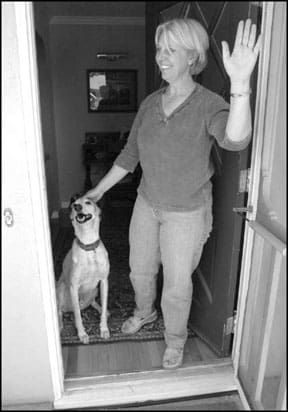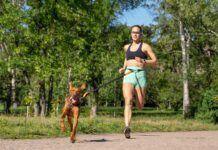Like most positive trainers, I constantly remind my students that, whether they are conscious of it or not, they are training their dogs every moment they spend together. Whatever you choose to reinforce — even when you’re not in a formal training session — will affect your dog’s future behavior. The things that your dog does that you frequently reinforce are likely to increase, so it makes sense to reinforce him as frequently as you can for the behaviors that you enjoy.
Here’s an interesting and powerful side-effect of frequent positive reinforcement: This practice can not only influence your dog’s behavior in a way that you like, but also improve your relationship in a sort of positive feedback loop. When a dog (or anyone!) is rewarded, it makes him feel good – about himself and the person giving the reward. And when your dog feels good about you, it tends to make him want to be with you more, and it motivates him try to earn even more reinforcements. Said simply, frequent positive reinforcements strengthen the relationship between you and your dog.
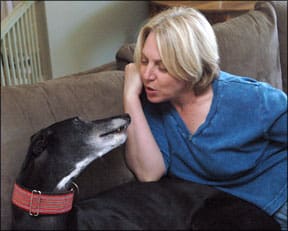
288
The Center for the Human-Animal Bond at the Purdue University School of Veterinary Medicine defines the bond that connects us to our beloved canines as “…the dynamic relationship between people and animals in that each influences the psychological and physiological state of the other.” It also says that “People in the presence of animals are often perceived to be more happy and healthy.” But what about the happiness and health of the animals? If we do a good job as caretakers on our side of the dog-human bond, our dogs should be happier and healthier in our presence as well.
This leads us to the underlying foundation of the positive training philosophy (training without force, pain, or fear) where the goal is to create dogs who are joyful and willing partners in our activities. It also underscores the contrast with old-fashioned thinking: “My dog should do what I ask because he ‘loves’ or ‘respects’ me – not because he might get a treat.” Those who espouse this anti-treat position usually train with prong collars, choke chains, and even shock collars. Ultimately their dogs’ performance has nothing to do with love, and everything to do with pain avoidance and fear of unpleasant consequences.
How simple it is to help our dogs be healthier and happier – and well-trained – by remembering to reinforce them frequently during our interactions with them throughout the day, especially when we take advantage of the wide range of reinforcers available to us. The bond isn’t just about food – although food, because it’s a strong, primary reinforcer for most dogs, is certainly a part of it. Other powerful reinforcers include toys, play, attention, touch, and the sound of your voice.
Relationship-building opportunities
Psychologist John Gottman, a marital and relationship researcher based at the University of Washington, has conducted dozens of studies in which the interactions between a couple are recorded and analyzed, in order to try to predict the ultimate success or breakup of the relationship.
Gottman’s researchers closely observe the subjects’ body movements and posture, facial expressions, tone of voice, and content of their speech, and each minute expression is categorized into either a positive, affirming category, or a negative category.
Further, Gottman and his researchers look for and tally what they call “bids” – moments in which one of the partners attempts to seek out attention or affirmation from the other. These bids can be a verbal question, a look, an affectionate touch, or any single expression that says, “I want to feel connected to you,” says Dr. Gottman. A response to a bid can be a turn toward, away, or against the other’s request for emotional connection.
Gottman stores this data, then tracks the couples over time, to see which ones end up separating or divorcing and which ones stay together. He then analyzes all the data, looking for interactions that predict whether or not the couple succeeds in staying together. He now claims that within five minutes of observing a couple interact, he can predict, with 91 percent accuracy, whether the couple will ultimately separate or stay together. What is he looking for? In short, more positive expressions than negative ones, and more positive responses to the partners’ bids for attention than moments in which these bids are ignored.
Interestingly, Gottman found that people who (consciously or unconsciously) ignore their partners’ bids more often than they respond to them are just as unsuccessful in their relationships as people who are negative with their partners. Husbands who eventually were divorced ignored the bids from their wives 82 percent of the time, compared to 19 percent for men in stable marriages. Women who later divorced ignored their husbands’ bids 50 percent of the time, while those who remained married only disregarded 14 percent of their husbands’ bids.
What on earth does this have to do with positive dog training? Studies of this kind have not been conducted with dogs, but based on my own anecdotal experience, I’m certain that similar statistics would emerge from a canine/human relationship study. I’d be willing to bet the farm that the more frequently a person looks at her dog with a happy, playful, or otherwise positive expression; engages her dog in a way the dog clearly enjoys (petting, running, sitting together); and rewards her dog with something the dog likes (food, praise, toys, play, petting), the more likely the dog is to be well-trained, well-behaved, and secure in that person’s home for life.
Dogs are no different from humans; almost everyone responds positively to others who are attentive, interested, and responsive to us. So, to build a strong relationship with your dog, take as many opportunities as you can to respond to your dog’s “bids” for attention, and reward him for responding appropriately to yours.
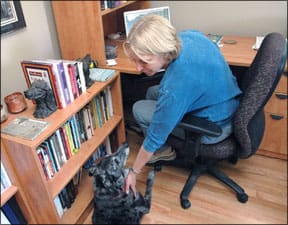
288
These moments don’t have to be big; I’m talking about frequent, small gestures. For example, you can simply say “Good dog!” in a bright, happy tone when you notice your dog looking at you. Toss him a treat when you walk by as he’s lying in the sun. “Catch him in the act” of lying quietly on his bed and rub his chest or tummy, as he prefers. Try to notice when he goes to the door and open it for him right away. Give him something he likes – a toy, a quick play session, a treat – if he comes into the room when you are watching TV and offers a sit and eye contact. The point is to not ignore him during moments of potential interaction; reinforce him, even in a small or momentary way.
Of course, another tenet of positive training is that it’s best to ignore – not reinforce in any way, with any attention whatsoever –those behaviors we would like to extinguish.
So if your dog’s “bid” for attention is jumping up on you, persistently nudging your elbow as you try to work on the computer, or barking at you, the last thing you want to do is reward or reinforce him – even with so-called negative attention, such as yelling at him or smacking him. Ignore him, even if you have to turn away or leave the room to do so. And try to respond positively within a minute or two after he ceases the negative sort of attention-seeking.
Keep a journal
One way to make yourself more aware of the opportunities you have in your daily life to strengthen your relationship with your dog is to keep a journal – even if only for a day. Make a note every time you have a positive interaction with your dog.
If the number of notations for the day is very low – say, less than four or five – it should alert you that you are not being as reinforcing, enjoyable, or significant to your dog as you should be. Try to increase the number . . . try to discover what the highest number of positive interactions you can have in a day!
If you make steady progress in increasing the number of times you have small, reinforcing moments with your dog, you’ll be sure to see his behavior, and your relationship improve.
My husband Paul and I have a pack of dogs – they are impossible to ignore! Seriously, though, we try to make sure that each dog has numerous positive interactions with us throughout the day. Here is a sample journal, so you can see what sort of interactions I’m trying to encourage you to have with your dogs!
6:00 am – The alarm goes off. Time to hop out of bed (or crawl, depending on my mood) to clean stalls and feed horses. As I stumble to the bathroom I pass Dubhy, our Scottish Terrier, lying on his foam pad by our bed. I give him a warm “Good morning Dubhy!” as I stoop to run my hands over his wiry coat, pet his furry face, scratch his ear, and rub his tummy when he rolls belly up for more attention.
6:10 am – I’m sitting on the bed, putting on my socks, and Missy, our Australian Shepherd, wanders over and sits with a beguiling look on her face. “Hi Miss Miss,” I say as I scratch her behind the ear.
6:20 am – Dressed and ready to hit the manure fork, I greet Bonnie (Scottie/Corgi mix) and Lucy (Cardigan Corgi) as I let them out of their crates and we head down the stairs to the landing. There we pause while I trade Bonnie a treat for Paul’s (husband) sock that she nabbed on her way out of the bedroom. “Bonnie, give. Yes!” and treat.
6:20 am – Now we play the “wait!” game on the stair landing while I descend to the bottom of the stairs, occasionally returning to the landing to award treats for good “wait” behavior. (This ritual is to save me from becoming entangled with 16 happy dog legs as we all troop down the stairs.)
Finally I reach the bottom of the staircase and invite them all to come down. Major reinforcement for the “wait” behavior: we’re all headed for the barn!
6:25 am – Similar rituals happen at the back door as Lucy and Missy sit and wait to be let out, and Dubhy and Bonnie sit to be leashed and go out with me.
6:30-8:00 am – Tons of bonding moments, as Paul and I do barn chores. Some of the highlights:
•We kick and throw a ball endlessly for Lucy to chase and fetch.
•Dubhy gets to ride in the empty wheelbarrow (his favorite thing) on return trips from the manure pile.
•Bonnie and Dubhy get treats for waiting quietly while shut in the hay room, hanging out on the hay stack, while we move horses in and out.
•All four dogs park themselves outside a boarder’s stall waiting for us to bring out her food bucket – this horse always leaves a little grain in her bowl and the dog’s delight in cleaning up the bits of molasses-flavored grain when we dump the bucket out on the barn floor.
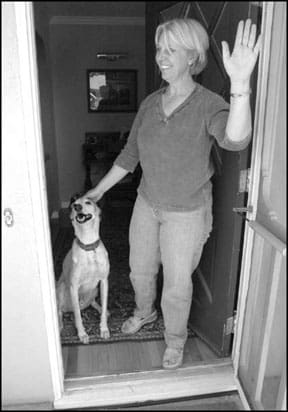
288
•Paul kneels and calls Lucy when he returns from feeding horses across the road. Lucy, delighted to see him, charges up the barn aisle and throws herself into his lap.
•I play the trade game with Bonnie again. This time she gets a chunk of dried beef liver in exchange for the fledgling sparrow she’s retrieved from the indoor arena. The unharmed baby bird is stashed in a box until we’re done with chores, at which time he’ll be released to the care of his anxious parents.
•Paul loads water buckets into the wheelbarrow to dump them in the indoor arena. Lucy follows at his heels, eager to play one of her favorite games – “chase the water” as it flies through the air and splashes on the arena surface.
•Missy runs up to me with a sparkle in her eye, inviting me to take a break from sweeping the barn aisle to play “puppy rush” with her. I’m happy to oblige.
•Finally, done with chores, we troop to the tack room for another “wait at the door ritual” and head for the house. I won’t bore you with a moment-by-moment rendition of the rest of the day, but here are a few more highlights:
•Feeding time is happy time! Lucy gets a treat for “woo-wooing” instead of barking as she waits for her meal. Everyone does a sit/wait for food bowl delivery.
•Lunch time. I eat on the back deck and play with the dogs – tossing a disc toy for Lucy to retrieve while playing a “down/wait” game with Bonnie to prevent her from spoiling Lucy’s fun (otherwise she’ll try to play tug with Lucy’s disc toy). Missy and Dubhy get random treats and massage.
•Private client with a reactive dog. Lucy, Missy, and Bonnie get to take turns playing “neutral” dog for counter-conditioning and desensitization practice. They love this game; they get lots of treats, too. Dubhy doesn’t get to play; he has his own dog-reactive issues!
•Hike the farm – a favorite for all of us. Lucy, Missy, and Bonnie get to run off-leash. Lucy and Missy stay close. Bonnie ranges farther afield but checks in regularly for family recall games. Dubhy, on a 40-foot long line, plays recall games in between checking out gopher holes.
•Evenings in the living room. Bonnie and Dubhy cuddle with me on the sofa while I type on my laptop. Lucy, at my feet or on the sofa, gets counter-conditioning treats when a cat enters the living room, or if a dog barks on television. All four cluster around Paul’s recliner when he opens a box of pretzels; they know pretzel pieces will come flying their way. When the pretzels are gone, Lucy claims her favorite spot and falls asleep cuddled in Paul’s lap on his recliner.
•Go to bed. Bonnie and Lucy fly up the stairs to their crates when they hear this bedtime cue. Dubhy waits on the landing for an extra bedtime cookie, and Missy follows at my heels up the stairs to bed.
I give Lucy bedtime treats in her crate, then trade Bonnie treats for the sock she’s taken to bed in hers. Missy gets a last scratch behind the ear along with her bedtime cookie. Dubhy hops up his bedsteps onto the bedspread, waiting for us to climb in and give him his bedtime massage, curled between us as we watch the Tonight Show.
Because I work from home, I’m fortunate to have endless opportunities throughout the day to do things that will enhance my relationship with my dogs. Even still, I sometimes feel I don’t do enough. I should hike with my dogs every day – and I don’t. I should groom each of them every day – and I don’t. I should do formal training sessions with each of them every day – and I don’t. But I always have dog cookies in my pockets. You never know when a bonding opportunity might present itself!
Pat Miller, CPDT, is Whole Dog Journal’s Training Editor. Miller lives in Hagerstown, Maryland, site of her Peaceable Paws training center. Pat is also author of The Power of Positive Dog Training; Positive Perspectives: Love Your Dog, Train Your Dog; Positive Perspectives II: Know Your Dog, Train Your Dog, and the brand-new Play with Your Dog.


